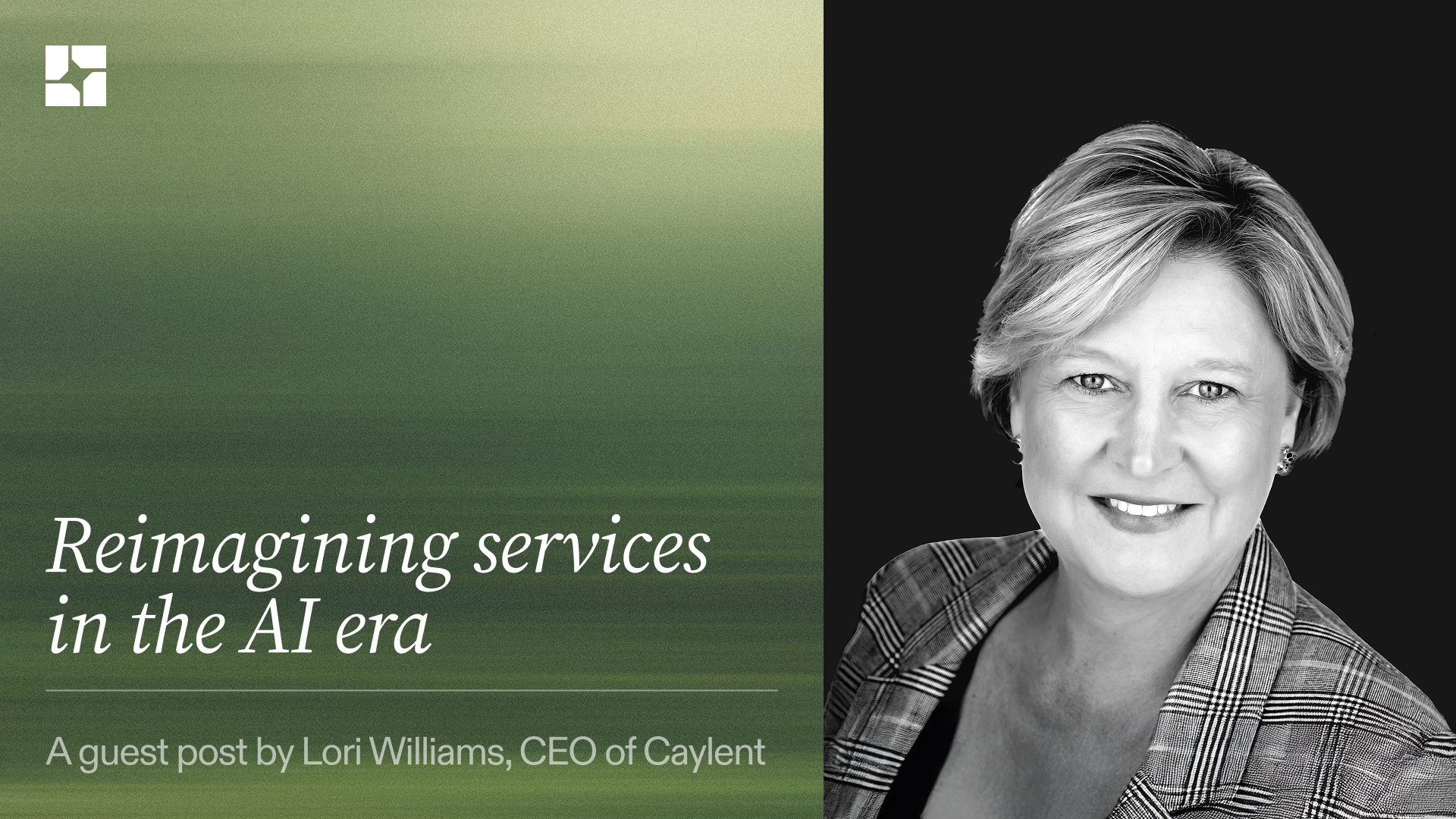Reimagining services in the AI era

Lori Williams
CEO at Caylent
Share to

Lori’s keynote on these topics at Flatfile’s Axis25 executive summit resonated powerfully with our audience. We invited her to share that perspective more broadly through this guest post.
If you’ve been in tech long enough, you’ve seen a few shifts. Client-server. Cloud. Mobile. Each one reshaped how we worked, built, and delivered. But what we’re living through right now with AI isn’t just another shift. It’s a wholesale redefinition of how services get delivered—and what “services” even means.
At Caylent, we’re not just responding to change. We’re participating in it. Building for it. And like many of you, while we have a clear framework of what we want to do things are changing so rapidly that there is a significant amount of figuring it out as we go. This post captures the questions we’re asking, the frameworks we’re leaning on, and the real-world experiments we’re running as we rethink services from the ground up.

We’re not in Kansas anymore: the AI Era isn’t a trend. It’s a new operating system.
AI isn’t just an incremental upgrade. It’s a convergence of three major forces:
Industrial-style automation that changes how work gets done.
Renaissance-style creativity, democratizing access to creation.
iPhone-style ubiquity, putting powerful tools into everyone’s hands.
That’s why ChatGPT hit 100 million users in two months. And why organizations—especially services firms—must rethink their operating model now, not later. Because in this world, agility favors the newcomer. Legacy moats erode quickly. And what made you successful before won’t keep you relevant tomorrow.

What this means for your customers
Your customers want transformation—fast. But they’re also dragging a lot of baggage.
What they’re dealing with:
Tech debt built over decades
Fragmented data landscapes
Business processes that can’t keep pace with today’s expectations
What they expect now:
Faster delivery of new capabilities
Insight from their data, not just storage
Predictive, personalized experiences from day one
AI isn’t a silver bullet, but it does help you “Marie Kondo” your backlog. At Caylent, we’ve seen customers cut a 65-day compliance backlog down to 4 days, modernize HVAC systems to reduce energy spend by 25%, and proactively manage water usage with AI-powered alerts. These aren't moonshots—they’re achievable outcomes when you pair the right strategy with the right technology.

Why the services industry must change
For decades, services meant people. Hours. Staffing. The occasional IP-based accelerator. But now? We're entering a hybrid era—where agents, tooling, and orchestration layers work alongside people to deliver value.
Think of it as Services-as-Software: modular, intelligent, and increasingly autonomous.
Three critical shifts are underway:
The talent pyramid flips: AI is replacing repetitive, junior-level work. Senior talent becomes even more critical—for orchestration, architecture, and oversight.
Product management becomes core: Services teams need PMs to design offerings, manage internal tools, and evolve with the ecosystem.
Methodology goes post-agile: Delivery isn’t linear anymore. We’re validating before building, iterating everywhere, and using AI to scaffold faster than ever.
This isn’t about eliminating people. It’s about augmenting them. And rethinking what kind of work humans are best equipped to do.

How we’re doing it at Caylent
We’ve committed to having 80% of our projects using AI meaningfully by the end of 2025. Not just chatbots and copilots, but end-to-end tooling that accelerates everything from scoping to delivery.
Here’s what that looks like in practice:
Sales to delivery: We use AI to analyze pre-sales calls and auto-generate first-draft SOWs.
Build acceleration: From those SOWs, we generate Jira backlogs, spin up infra scaffolding, and hand engineers a head start.
Post-delivery: Self-healing systems, AI-driven bug resolution, and intelligent extensions reduce the long tail of support.
The biggest unlock? We’re no longer starting from zero. And our engineers spend more time solving business problems instead of stitching together transactional code.

Lessons we’ve learned along the way
Scaling AI across a services organization doesn’t happen by accident. It takes focus, iteration, and a willingness to rethink the fundamentals. These lessons we’ve learned along the way continue to anchor our approach.
You don’t need all the answers to get started. But you do need the conviction to try and discipline to navigate the rapid changes.
Experimentation is a muscle. Build it into your culture. Treat failure as data.
Prompt engineering is strategic thinking. It’s not just a skill; it’s a mindset.
Talent strategy must evolve. If AI handles transactional work, how will you grow your next generation of architects?
Get your house in order. Messy data, broken processes, and legacy platforms will slow you down.
We’ve created internal goals, cross-functional teams, and an AI badge initiative to upskill everyone from engineers to finance. And we’re tracking adoption monthly in town halls. Because transformation doesn’t happen by osmosis—it needs visible commitment.
The takeaway: AI is creating an entirely new category of services
Just as SaaS changed software, AI will redefine services. We’re heading toward a world where:
The line between Services and Product becomes even more blurry
Pricing is outcome-based, not hour-based.
Services are delivered with software precision.
Teams are hybrid: human + agentic + orchestrated.
If you’re in services, now is the time to ask hard questions, test new approaches, and get on the train. The future’s moving fast—and the ones who learn fastest will lead.

